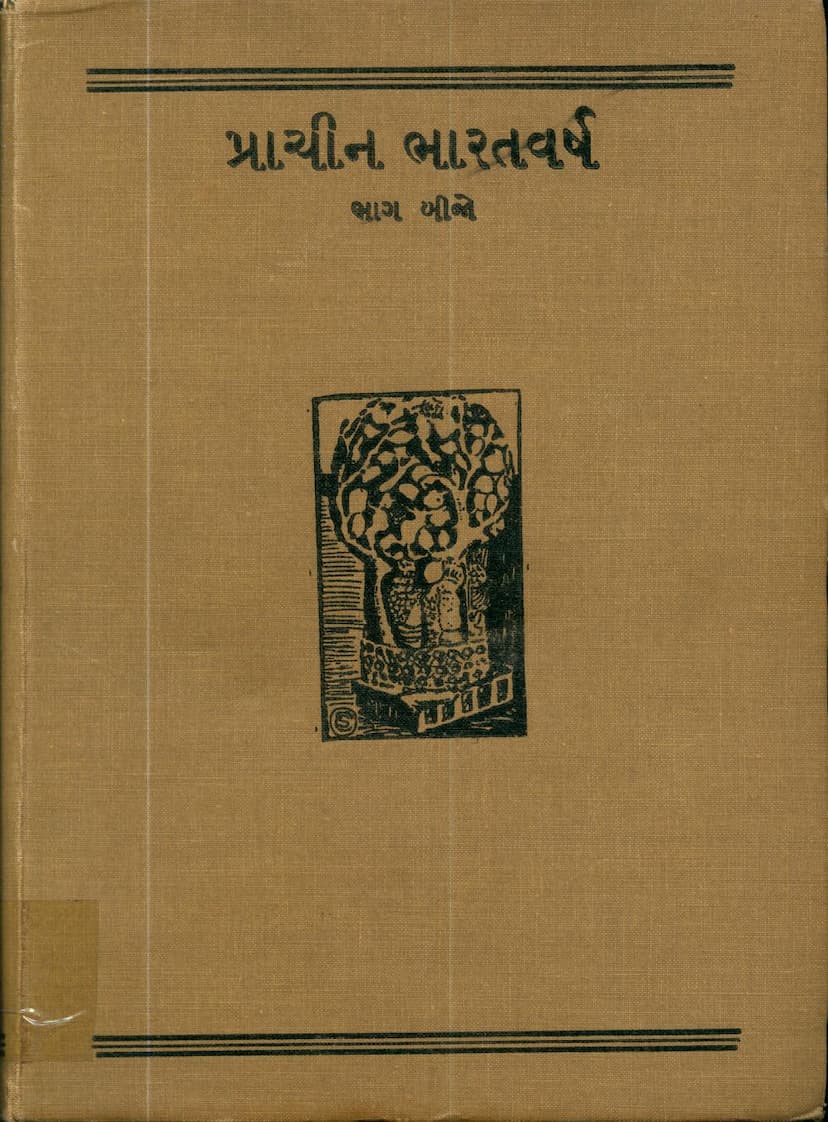Prachin Bharat Varsh Part 02
Added to library: September 2, 2025

Summary
This is a comprehensive summary of the Jain text "Prachin Bharat Varsh Part 02" by Tribhuvandas Laherchand Shah. The book delves into the history of ancient India, focusing on the period from 900 BCE to 100 CE. This specific volume, Part 02, covers the Maurya dynasty, providing a detailed historical analysis based on inscriptions, archaeological findings, and the accounts of credible historians.
Here's a breakdown of the key aspects covered in the text:
Overall Scope and Approach:
- Historical Methodology: The author emphasizes a rigorous historical approach, analyzing ancient artifacts and inscriptions to reconstruct the past. The text highlights the importance of cross-referencing historical data from various sources, including Jain literature, archaeological findings, and foreign accounts.
- Jain Perspective: The book is written from a Jain perspective, analyzing historical events and figures through the lens of Jain teachings and traditions. This is evident in the interpretation of symbols, rituals, and the emphasis on figures like Lord Mahavir and the Jinas.
- Chronology and Dating: A significant focus is placed on establishing accurate chronologies and dating historical events, often challenging prevailing assumptions based on a critical analysis of available evidence.
- Debunking Myths and Misconceptions: The author aims to correct historical inaccuracies and challenge widely held beliefs, particularly regarding the religious affiliations of rulers and the origin of certain historical figures and practices.
Key Content Areas Covered in this Volume (Part 02):
- The Maurya Dynasty: This volume dedicates significant attention to the Maurya dynasty, aiming to present a more thorough and accurate account than previously available.
- Chandragupta Maurya: The book explores Chandragupta's life, lineage, and his rise to power. It critically examines the historical accounts regarding his origins, questioning the traditional narrative of his caste and challenging the identification of 'Sandracottus' in Greek texts with Chandragupta. The author suggests a different interpretation of historical events, including the timeline of Chandragupta's reign and his connection to Jainism.
- Chandragupta's Faith: A major argument presented is that Chandragupta Maurya was a follower of Jainism. The text cites the influence of Guru Chandragupta and the alleged Jainism of his minister Chanakya as evidence. The author also analyzes the significance of symbols found on coins and inscriptions, interpreting them as Jain in origin.
- Chanakya (Kautilya): The book offers insights into the life of Chanakya, discussing his contributions to political science and his likely Jain leanings. It explores the origin of his names and his analytical approach to governance.
- Bindusara: The text touches upon Bindusara's reign, his family, and the limited information available about his religious affiliations.
- Ashoka and Priyadarshin: A significant portion of the book is dedicated to distinguishing between Ashoka and Priyadarshin, arguing that they were two different individuals. The author asserts that the inscriptions attributed to Priyadarshin are primarily Jain in nature and reflect Jain principles. The book analyzes Ashoka's reign, his conversion to Buddhism (as per prevailing accounts), and the implications of this conversion on historical interpretations, while also emphasizing the Jain context of the period.
- Reign of Priyadarshin: The author details Priyadarshin's reign, his personal life, his conquests, his administration, his foreign relations, and his significant contributions to society and ethics. The text highlights the author's belief that Priyadarshin's religious practices were deeply rooted in Jainism, and that many historical artifacts attributed to Buddhism actually belong to Jainism.
- Coins and Symbols: The book extensively discusses ancient Indian coins, their types, origins, evolution, and the significance of the symbols found on them. The author dedicates considerable effort to interpreting these symbols, particularly those related to Jainism, and argues that many symbols attributed to Buddhism are actually Jain in origin.
- Social and Religious Life: The text sheds light on the social and religious landscape of ancient India during the Maurya period, discussing the influence of Jainism on political life, the prevalence of various religious practices, and the role of different communities.
- Historical Analysis and Debates: The author engages with various historical debates, such as the identity of 'Sandracottus', the religious affiliations of Mauryan emperors, and the chronology of significant events. The text aims to present a re-evaluation of these historical aspects, proposing new interpretations based on the author's research.
Specific Arguments and Interpretations:
- Jainism's Prominence: The author strongly argues that Jainism played a central role in ancient Indian history, influencing the political and social fabric of the time, and that many historical accounts attributed to Buddhism are actually rooted in Jain traditions.
- Ashoka vs. Priyadarshin: A key argument is the distinction between Ashoka and Priyadarshin, with Priyadarshin being identified as a devout follower of Jainism whose inscriptions reflect Jain tenets.
- Coinage Interpretation: The interpretation of coin symbols, particularly the elephant and the bull, is central to the author's argument for Jain influence.
- Critique of Existing Scholarship: The author critically examines the works of previous historians and archaeologists, pointing out what he believes to be errors or biases, particularly in attributing Jain artifacts and historical events to Buddhism.
Overall Contribution:
"Prachin Bharat Varsh Part 02" is presented as a scholarly work that aims to provide a fresh perspective on ancient Indian history, particularly the Maurya period, with a strong emphasis on uncovering and highlighting the significant role of Jainism in shaping the subcontinent's past. The author's detailed analysis and willingness to challenge established narratives make this a notable contribution to the study of ancient Indian history from a Jain viewpoint.